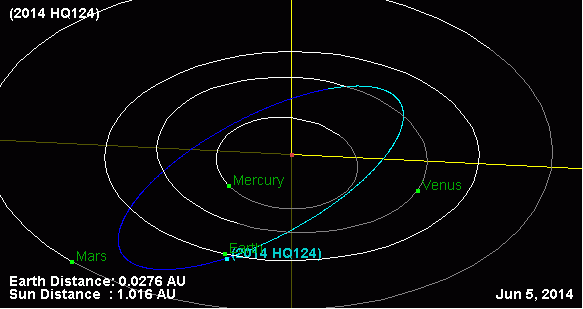Potentially Hazardous Asteroid 2014 HQ124 Live Stream: Watch 'The Beast' Make Its Way Past Earth Here

A potentially hazardous asteroid, first discovered on April 23, is making its way past Earth on Thursday. Slooh will broadcast the asteroid 2014 HQ124, dubbed "the Beast," live stream beginning at 2:30 p.m EDT.
At first, the near-Earth asteroid lived up to its billing as a gigantic celestial object. Based on its brightness, the albedo, astronomers initially pegged the diameter of asteroid 2014 HQ124 at approximately 400 to 900 meters (1,312 to 2,953 feet) but new data from NASA's NEOWISE spacecraft estimates the Beast's size at 325 meters (1,067 feet). For a size comparison, the Chelyabinsk meteor was 17 to 20 meters (56 to 66 feet) while the most recent close approach occured on May 4. Asteroid 2014 HL129 was discovered on April 29 and passed Earth at a distance of 186,000 miles away and measured 25 feet in diameter.
According to NASA, asteroid 2014 HQ124 was discovered in April by Wide-field Infrared Survey Explorer (WISE) spacecraft. Even though the size of the asteroid has been downgraded, it's an incredibly large object and on June 8 it will pass Earth at 3.2 lunar distances and is not a threat to collide with the planet. The last time an asteroid the size of 2014 HQ124 passed Earth at such a close distance was in 2005 when the potentially hazardous asteroid 2005 YU55 passed within 0.85 lunar distances.
Slooh reports asteroid 2014 HQ124 is traveling at a speed of 31,000 miles per hour. Bob Berman, Slooh astronomer, said in a statement "If it were to impact us, the energy released would be measured not in kilotons like the atomic bombs that ended World War Two, but in H-Bomb type megatons. It will be interesting indeed to watch Slooh track and image this substantial intruder as it passes less than a million miles of us, at a speed 17 times greater than that of a high speed rifle bullet."
Slooh will broadcast its observations of asteroid 2014 HQ124 from its observatory in the Canary Islands. The live stream begins at 2:30 p.m. EDT and can be viewed below.
© Copyright IBTimes 2024. All rights reserved.





















